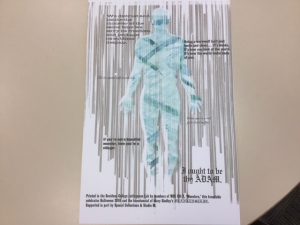
Broadside Celebrating the Bicentennial of Mary Shelley’s Frankenstein and Halloween 2018
It’s been 200 years since the publication of Mary Shelley’s story of a creature created in a laboratory. In the cinematic adaptations, the creature is stitched together, composed of body parts taken from corpses and medical specimens (and a famously “abnormal” brain). Given this collage-like nature of Frankenstein’s creation, it seemed fitting to mark both the bicentennial of Shelley’s publication and Halloween 2018 with an “exquisite corpse”-style letterpress print. In the Surrealist technique of the exquisite corpse, multiple authors or artists contribute short fragments to a single composition, with the result being a collaboratively composed final work that often demonstrates striking, unexpected juxtapositions.
In our practice of the exquisite corpse, volunteers from Professor Sample’s WRI-101 course (“Monsters”!) visited the new and developing Letterpress Lab in the Wall Center for a brief overview of typesetting and letterpress printing. After an introduction to the anatomy of moveable type (including the face, foot, belly, shoulder, and beard of the individual pieces of type, known as “sorts”), and the basics of typesetting (upside-down, from left to right), students selected typefaces and then set short quotations they’d brought with them, drawn from their readings in all things monsterish. Some had chosen extracts from novels, while others had more theoretical excerpts. When typesetting was complete, the students’ individual quotations were then gathered together onto one of two mid-century Vandercook proof presses, and locked into place in the bed of the press.
The following day, students returned to print their type on large-format sheets previously printed with an appropriate background: a monsterish, vaguely human silhouette emerging from a visually noisy background. Perhaps appropriate to the occasion (a celebration of what is sometimes called the first work of science fiction), these background sheets were produced on the letterpress but by means of a decidedly twenty-first century technique known as “pressure printing,” and in this specific case enabled by the technology of the laser-cutter in the college makerspace Studio M. Pressure printing is a little bit like stenciling, but rather than applying pigment onto a sheet through a stencil, the stencil itself is placed behind the sheet, and the pair are run through the letterpress. Ink transfers unevenly from the press to the print—a “mistake” in traditional letterpress practices!—according to the presence or absence of the material behind the printed sheet. In this case, a negative and then a positive stencil were used to create, respectively, the background field (silver) with a silhouette removed, and the foreground figure (variably inked) with the background removed. Hand inking of the figure produced a stitch-like effect, which continued the monsterish and collage-oriented approach to the print. In the short edition (limited to 40), no two prints are the same.
